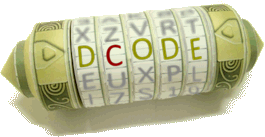Tool to convert electronic configuration of atoms. Electronic configuration of atoms or molecules is a notation describing the position of electrons by orbitals, by couples of digits and letters.
Electron Configuration of Atoms - dCode
Tag(s) : Physics-Chemistry, Notation System
dCode is free and its tools are a valuable help in games, maths, geocaching, puzzles and problems to solve every day!
A suggestion ? a feedback ? a bug ? an idea ? Write to dCode!
Electron Configuration of Atoms
Electron Configuration Search
Conversion of EC into atoms (Reverse Search)
Answers to Questions (FAQ)
How to convert an electron configuration to atomic symbols?
From the current list of atomic configurations known, it is necessary to replace the configuration by the atomic symbol in the periodic classification of Mendeleiev (the atom Ne, Ar, Kr, Xe ou Rn is optional)
Example: (Ar) 3d2 4s2 = Titane = Ti
To convert to atomic number, use the periodic classification of elements.
How to convert an atom to its electronic configuration?
For each symbol of a detected chemical element, it is converted to its ground state electronic configuration notation, by orbital layers. (The layers of Ne, Ar, Kr, Xe or Rn atoms are ignored when writing)
Example: C = Carbon = 1s2 2s2 2p2
Example: Fe = Iron = [Ar] 3d6 4s2
Example: Cl = Chlorine = [Ne] 3s2 3p5
Example: Cu = Copper = [Ar] 3d10 4s1
Source code
dCode retains ownership of the "Electron Configuration of Atoms" source code. Any algorithm for the "Electron Configuration of Atoms" algorithm, applet or snippet or script (converter, solver, encryption / decryption, encoding / decoding, ciphering / deciphering, breaker, translator), or any "Electron Configuration of Atoms" functions (calculate, convert, solve, decrypt / encrypt, decipher / cipher, decode / encode, translate) written in any informatic language (Python, Java, PHP, C#, Javascript, Matlab, etc.) or any database download or API access for "Electron Configuration of Atoms" or any other element are not public (except explicit open source licence). Same with the download for offline use on PC, mobile, tablet, iPhone or Android app.
Reminder: dCode is an educational and teaching resource, accessible online for free and for everyone.
Cite dCode
The content of the page "Electron Configuration of Atoms" and its results may be freely copied and reused, including for commercial purposes, provided that dCode.fr is cited as the source (Creative Commons CC-BY free distribution license).
Exporting the results is free and can be done simply by clicking on the export icons ⤓ (.csv or .txt format) or ⧉ (copy and paste).
To cite dCode.fr on another website, use the link:
In a scientific article or book, the recommended bibliographic citation is: Electron Configuration of Atoms on dCode.fr [online website], retrieved on 2025-12-20,
